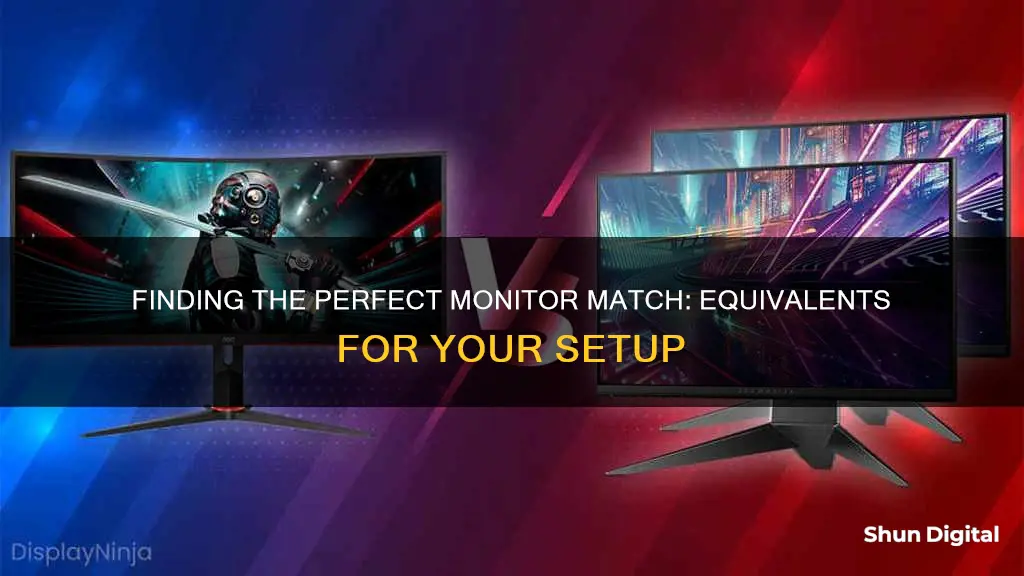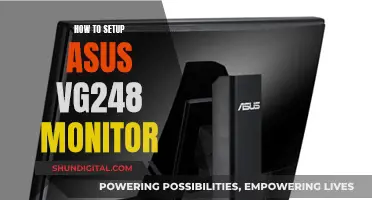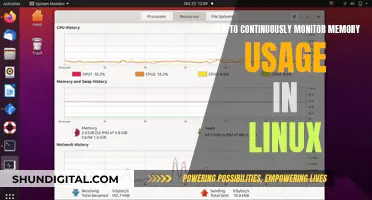
When it comes to finding an equivalent monitor, there are several factors to consider. Firstly, it's important to identify the intended use case, as different activities have varying monitor requirements. For example, a multimedia professional such as a photographer or graphic designer would need a monitor with a larger screen, high resolution, and accurate colour reproduction, while a casual user might only require a lower-priced monitor with basic features for everyday tasks like browsing the web or using social media. Gamers, on the other hand, should opt for monitors with high refresh rates, fast response times, and technologies like NVIDIA G-SYNC or AMD FreeSync for a smoother gaming experience. The size of the monitor is also a key consideration, with larger displays offering more screen real estate but potentially taking up more desk space. Additionally, the resolution, such as Full HD, Quad HD, or 4K, will impact the sharpness and clarity of the display. Other factors to keep in mind include the panel type (IPS, VA, TN, or OLED), brightness, contrast ratio, viewing angle, and additional features like built-in speakers or webcams. By carefully evaluating these specifications, you can find an equivalent monitor that suits your specific needs and preferences.
| Characteristics | Values |
|---|---|
| Purpose | Everyday use, gaming, professional use (e.g. photo and video editing) |
| Display Type | IPS, VA, TN, OLED, LED, LCD, QLED |
| Screen Size | 23"–24", 27", 32", 34", 49" |
| Resolution | HD, Full HD, Quad HD, 4K Ultra HD, 5K |
| Response Time | 5ms or less |
| Refresh Rate | 60Hz or faster |
| Viewing Angle | 178° or more |
| Brightness Level | 250 cd/m2 or higher if used in a bright room |
| Contrast Ratio | Dynamic contrast ratio |
| Adaptive Sync | AMD FreeSync, Nvidia G-Sync, VESA AdaptiveSync |
| Ports and Connections | HDMI, DisplayPort, DVI, VGA, USB-C |
| Additional Features | Built-in webcam, speakers, dual-monitor stands, adjustable stands, VESA compliant |
What You'll Learn

Monitor types: TN, IPS, VA, and OLED panels
There are several types of monitor panels, each with its own advantages and disadvantages. Here is an overview of the four main types: TN, IPS, VA, and OLED.
TN (Twisted Nematic) Panels
TN stands for Twisted Nematic, which refers to the way the liquid crystals are twisted between two polarizing filters. TN panels are known for their fast response times and high refresh rates, making them a popular choice for gaming monitors. They are usually the most affordable option and are common entry-level monitors. However, they often have poor colour reproduction and viewing angles.
IPS (In-Plane Switching) Panels
IPS, or In-Plane Switching panels, are known for their excellent colour reproduction and wide viewing angles. They are commonly used by professionals who require accurate colour representation, such as photographers and graphic designers. IPS panels are more expensive than TN panels but offer superior image quality.
VA (Vertical Alignment) Panels
VA stands for Vertical Alignment and refers to the vertical alignment of the crystals. VA panels offer a good balance between colour reproduction and contrast ratios, allowing for brighter whites and darker blacks. They are usually a more affordable option than IPS panels but may have slower response times, which can cause ghosting issues in high-motion games.
OLED (Organic Light-Emitting Diode) Panels
OLED panels are different from the other three types as they do not use a backlight. Instead, each pixel emits its own light, resulting in higher contrast ratios and more vibrant colours. OLED panels also have fast response times and high refresh rates, making them ideal for gaming. However, they are the most expensive option and may suffer from burn-in issues.
Choosing the Right Monitor Type
When choosing a monitor, it is important to consider your specific needs and budget. If you require accurate colour reproduction and wide viewing angles, an IPS panel may be the best option. If you are a gamer, a TN or OLED panel with high refresh rates and fast response times might be more suitable. For those looking for a balance between colour and contrast, a VA panel could be a good choice. It is also important to consider the size, resolution, and additional features of the monitor to ensure it meets your specific requirements.
Electricity Monitors: Accurate or Deceitful?
You may want to see also

Monitor size: 24-inch, 27-inch or 32-inch
The size of a monitor is an important choice when purchasing a new one. The bigger the screen, the easier it may be to view the picture, but the poorer the resolution or picture quality may be.
A 24-inch monitor is the default size for everyday use, office tasks, and school. Full HD (1080p) stays fairly sharp on monitors of this size. They are also suitable for gaming, although a larger size is more comfortable.
A 27-inch monitor provides a lot of screen space, making it very suitable for gaming, graphic design, and image editing. The larger size also means you're more immersed in your game or movie. For a 27-inch screen, it is recommended to have QHD or 4K resolution, as Full HD can look blurry.
A 32-inch monitor is a large screen for entertainment enthusiasts. They are very large when you sit close to them, so they are suitable for gaming and watching movies and series from a distance. To ensure the image remains sharp, a 32-inch 4K monitor or 1440p monitor is recommended.
If you are looking for a monitor for general and business use, a 24-inch monitor is a good option. For PC gaming, movies, and design, a 27-inch monitor is a better choice. If you are looking for a monitor for console gaming, movies, and design, a 32-inch monitor would be ideal.
Choosing the Right TV: Understanding Screen Size and Measurements
You may want to see also

Monitor resolution: 1080p, 1440p or 4K
When choosing a monitor, it's important to consider your needs and how you plan to use it. The resolution of a monitor defines how many pixels it has, affecting its sharpness and the detail in images. The three most common resolutions are 1080p, 1440p, and 4K. While 1080p is often sufficient for everyday tasks like email, social media, and web browsing, multimedia professionals and gamers may prefer higher resolutions.
1080p monitors are ideal for budget-conscious users and basic productivity tasks. They are widely available and affordable, with prices starting from $129.99. However, they may struggle to display higher-resolution media content correctly. For a step up in quality, 1440p monitors offer a "sweet spot" for both work and play, providing crisper visuals and more screen space. They are versatile and suitable for gaming, office work, and photo editing, with prices starting at $179.99.
If you require the sharpest image and text clarity, a 4K monitor is the best option. 4K monitors offer four times the pixels of 1080p models, resulting in exceptional image quality and ample screen space. They are ideal for high-resolution media content, extensive graphic work, and gaming. However, they require a powerful graphics card and can be more expensive, with prices starting around $200-$445. Additionally, 4K monitors may struggle to display low-resolution media well, as the content may appear stretched across the high number of pixels.
It's worth noting that the benefits of a higher resolution like 4K may only be noticeable if you sit close to the screen, within two to three feet. If you sit further away, a lower resolution like 1080p may be perfectly adequate. Ultimately, the right resolution depends on your personal preferences, intended use, and budget.
Designo Monitors: ASUS's Premium Display Lineup Explored
You may want to see also

Monitor refresh rate: 60Hz, 144Hz, 240Hz or 360Hz
The refresh rate of a monitor refers to the number of times the monitor refreshes itself per second. This is measured in hertz (Hz). A monitor with a 60Hz refresh rate will generate a new image 60 times per second, whereas a 144Hz monitor will do so 144 times per second, and so on. Higher refresh rates reduce motion blur and result in smoother visuals, which is especially beneficial for graphically demanding tasks like gaming or watching action movies.
For casual use, such as web browsing, social media, or online shopping, a 60Hz monitor is sufficient. For multimedia use, such as streaming music and movies, a 120Hz or higher refresh rate monitor is recommended for smoother motion. If you're a gamer, a refresh rate of 60Hz or faster is ideal, with faster refresh rates improving the gaming experience by reducing input lag and enhancing responsiveness. For fast-paced or competitive gaming, a 240Hz or 360Hz monitor is recommended, although this requires a high-spec computer to handle the high frame rates.
It's important to note that a very high refresh rate may be unnecessary for many people. For casual gaming, a 120Hz, 144Hz, or 165Hz monitor should be more than enough. If you prioritise resolution and colour accuracy, a graphics-oriented monitor with a 60Hz or 75Hz refresh rate will suffice. Additionally, consider the capabilities of your computer hardware when choosing a high refresh rate monitor, as you may need to upgrade your graphics card and CPU to fully utilise the monitor's potential.
Testing LCD Backlight: Quick Checks for Monitor Issues
You may want to see also

Monitor features: Built-in webcams, speakers, dual-monitor stands, ergonomic features
Monitor Features: Built-in Webcams
Built-in webcams are a convenient way to simplify your desktop setup, removing the need for an external webcam. Most built-in webcams are either tiny webcams built into the bezel or larger pop-up webcams, which can be more flexible and allow you to hide them when not in use. Some monitors also feature removable webcams that can be tilted and adjusted.
When choosing a monitor with a built-in webcam, it's important to consider the overall monitor quality and performance as your primary display. Additional features like USB hubs, colour management tools, built-in speakers, and microphones can further enhance your setup.
- ViewSonic VG2757V-2K 27 Inch 1440p Video Conference Docking Monitor (Best overall)
- Samsung M8 Smart Monitor (Best 4K)
- ASUS 27” 1080P Video Conference Monitor (BE279QSK) (Best budget)
- Philips Brilliance 499P9H (Best curved)
- Apple Studio Display (Best for Mac)
- PHILIPS 34E1C5600HE 34″ UltraWide QHD 21:9 Monitor (Best ultrawide)
Monitor Features: Speakers
Built-in speakers are a common feature in monitors with webcams, providing audio functionality for video conferences, streaming, and casual listening. While the sound quality of built-in speakers can vary from mediocre to poor, some premium monitors offer surprisingly good sound quality.
Monitor Features: Dual-Monitor Stands
Dual-monitor stands allow you to mount two monitors, providing an ergonomic and space-efficient solution for multi-monitor setups. These stands offer features such as full adjustability, including swivel, tilt, rotation, and height adjustment, ensuring optimal viewing angles and comfort.
- HUANUO Dual Monitor Stand
- VIVO Dual Monitor Desk Mount
- SUPERJARE Adjustable Dual Monitor Riser
- Ergotron – LX Vertical Stacking Dual Monitor Arm
- Bracwiser Dual Fully Adjustable Monitor Arm Stand Mount
- WALI Dual Monitor Desk Mount
- MOUNTUP Dual Monitor Stand for Desk
Monitor Features: Ergonomic Features
Proper monitor placement and ergonomic design can help prevent fatigue, eye strain, and neck and back pain. Here are some key considerations for ergonomic monitor features:
- Place the monitor at eye level: Adjust the height so that your eyes align with the top of the viewing area of the screen.
- Maintain a comfortable distance: Position the monitor at an arm's length away, typically around 20 inches or more.
- Centre the monitor: Set up the monitor directly in front of you to avoid twisting your neck or body.
- Reduce glare: Place the monitor perpendicular to a window, and tilt it slightly down if necessary to minimise reflections.
- Adjust for bifocals or progressive lenses: If needed, tilt the monitor backwards to avoid a poor neck position.
- Take breaks: Regularly rest your eyes by looking away from the screen and ensure proper lighting to avoid strain.
- Enlarge text: If the text appears small, adjust the font size or magnify the image to avoid leaning forward.
- Consider standing workstations: These can provide an alternative ergonomic option to traditional desk setups.
Monitoring Internet Usage on iPads: A Comprehensive Guide
You may want to see also
Frequently asked questions
First, consider what you will be using your monitor for. If it's for everyday activities like surfing the web, social media, and online shopping, you probably don't need a high-performance monitor with lots of extra features. If you're a gamer, you'll want to look for a monitor with a high refresh rate and a fast response time. If you're a creative professional, you'll want a large screen with a high resolution for detailed images.
The most common types of monitors are TN (Twisted Nematic), IPS (In-Plane Switching), VA (Vertical Alignment), and OLED (Organic Light-Emitting Diode). TN panels are typically used by gamers due to their fast response times, while IPS panels are the most popular option overall for their crisp images and wide viewing angles. VA panels offer improved contrast and image quality, and OLED panels provide the best image quality with deep blacks and accurate colours.
The most common monitor sizes are 24 inches, 27 inches, and 32 inches. While bigger screens can provide a more immersive experience, it's important to consider your available desk space and your field of view to avoid eye strain.
In addition to size and resolution, you may want to consider the refresh rate, response time, and connectivity options. If you're a gamer, look for a monitor with a high refresh rate and a fast response time to reduce motion blur and provide a smoother gaming experience. For connectivity, most modern monitors have HDMI, while some also offer DisplayPort, DVI, and USB-C connections.







